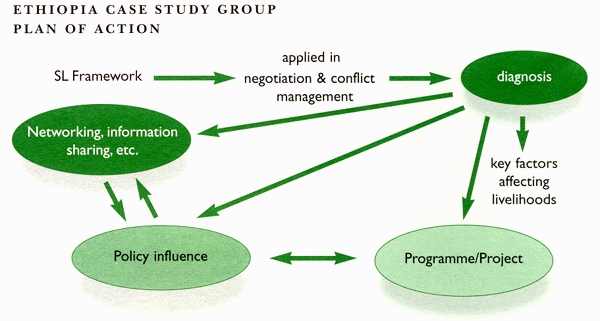 |
Forum participants emphasized that agencies did not need to wait for new projects or programmes in order to begin using SL approaches; there is much to be gained by applying SL principles to ongoing projects.
There was broad consensus in the Mali, Ethiopia, Mongolia and Bolivia working groups that the projects would have benefited had SL approaches been adopted from the outset. In the Ethiopian case study, SL approaches might have led project planners to reconsider the project's basic assumption that land degradation was the main cause of food insecurity. The understanding gained might have resulted in a very different project.
ETHIOPIA CASE STUDY GROUP Reviewing the Ethiopian project with an SL lens led participants to:
Expected outputs of the re-diagnosis are:
|

In the case of the Mali project, holistic diagnosis would have drawn out the community's development priorities. This would have avoided inappropriate entry points, provided the project with a greater poverty focus and encouraged greater ownership of the project among the community. However, broadening the scope of the project would also have increased the risk of implementing agencies finding themselves unable to cope with such a complex project.
TABLE 4 | |
Benefits and risks of SL diagnosis and design - Mali case study group | |
BENEFITS |
RISKS |
|
|
The Mongolia case study group concluded that, although a conventional project design would have been quicker, cheaper, easier and more acceptable to the Government and funding agencies, its disadvantages would have outweighed its potential advantages. The SL design would have been slower, more costly and riskier, but it would have resulted in a more flexible and focused project of greater relevance to the livelihood systems of herders with poor or average incomes.
TABLE 5 | |
A comparison of conventional and SL project designs - Mongolia case study group | |
ADVANTAGES OF CONVENTIONAL DESIGNS |
DISADVANTAGES OF CONVENTIONAL DESIGNS |
|
|
ADVANTAGES OF SL APPROACHES | |
| |
DISADVANTAGES OF SL APPROACHES | |
| |
The Mali case study group concluded that a redesign along SL principles would have redirected the aim of the project towards reducing the vulnerability of farmers to drought-induced crop failure. Greater awareness of the socio-economic make-up of the community would have increased the chances of reaching women and the poor. The feedback that farmers would have been able to give to management would have accelerated the joint learning and adaptation process. Had the need for an exit strategy been considered from the start, planners would have given higher priority to building sustainable village organizations that could have functioned independently once the project had ended.
TABLE 6 | |
Can SL approaches add value to design? - Mali case study group | |
OPPORTUNITIES FOR REDESIGN |
OBSTACLES FOR REDESIGN |
|
|